Ultrafast Fiber Optic Photodetectors

- Eight Models Cover Wavelengths from 700 nm to 1650 nm
- High-Fidelity Impulse Responses Down to 11 ps FWHM
- Internal Single Mode or Multimode Fiber with FC/PC Connector
- Bandwidths from 12 GHz to 50 GHz
DXM50AF
Single Mode, 50 GHz,
1250 - 1650 nm
Application Idea
The included ECM100 clamp can be used to securely mount the detector on a Ø1/2" post.
DXM25DF
Multimode, 25 GHz,
700 - 870 nm

Please Wait
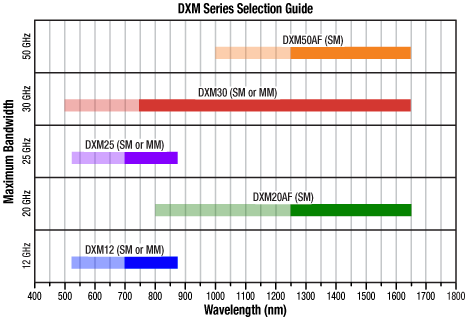
Click to Enlarge
While each DXM Series model is designed and intended for operation over the specified wavelength range, each will respond, with reduced performance, to optical input at shorter wavelengths, as shown by the shaded regions. See the Responsivity plots in the Specs tab for details. Please contact Tech Support for more information.

Janis Valdmanis, Ph.D. Optics
Ultrafast Optoelectronics
General Manager
Got Questions?
Our engineers and expertise are here for you!
If you are not sure whether our catalog items meet your needs, we invite you to contact us. Or ask about a loan, so you can try them out for yourself, in your own lab. We can also support custom or OEM requirements you may have.
Just press the button, and we'll get back to you within the next business day.
Features
- Visible, Near-Infrared, or Broadband Wavelength Ranges
- DC-Coupled Output
- Hermetically Sealed GaAs or InGaAs Detector Module
- Two Internal Fiber Options:
- SMF-28 Single Mode Fiber
- OM4 (Ø50 µm Core) Multimode Fiber
- RF Output Signal via 2.92 mm K or 1.85 mm V Connector®†
- Built-In DC Photocurrent Monitor
- Digital Output Sent to Display
- Analog Output via SMA Connector
- Replacement Power Supply Available
The DXM series of Ultrafast Detectors include single-mode and multimode fiber-coupled photodetectors with wide wavelength ranges, as shown to the right. Each provides a high-fidelity electrical output pulse in response to an optical input pulse, and their clean impulse responses have
Our single mode detectors contain 9 µm core SMF-28 single mode fiber, while our multimode detectors contain 50 µm core OM4 multimode fiber. Optical input can be coupled from an FC/PC-terminated fiber via the FC bulkhead connector. Our multimode ultrafast detectors are designed to accept input from multimode or single-mode optical fiber connectors, making them a versatile measurement instrument for research and commercial applications. We offer single mode and multimode hybrid patch cables to facilitate connecting optical cables with different connector types. RF signal output is available via a female 1.85 mm connector (Item # DXM50AF) or SMA-compatible 2.92 mm RF connector (all other detectors), which may be connected to a measurement instrument using suitable microwave cables or adapters. Measurements of the DC photocurrent can be viewed using the digital display, and an SMA jack on the input panel provides the analog current monitor output signal. Please see the Operation tab for additional information on functionality and operation.
Included with each DXM series detector head is a power adapter with a mini-B USB plug for charging the battery and a mounting bracket (ECM100, also available below) that snaps onto the side of the housing. The ECM100 bracket has a #8 (M4) counterbore, which allows easy mounting to a post or any other component with an 8-32 (M4) threaded hole.
The performance of each DXM series detector is factory tested and a test result summary is included with each detector (sample). The test results and tabular data for detectors purchased after January 16th, 2020 can be downloaded by clicking on the red Docs icon (![]() ) next to the Item # and entering your device's serial number under "Download Serial Item Data." Please contact Tech Support if you would like to receive test results for devices purchased before January 16th, 2020.
) next to the Item # and entering your device's serial number under "Download Serial Item Data." Please contact Tech Support if you would like to receive test results for devices purchased before January 16th, 2020.
| Webpage Features | |
|---|---|
| Clicking this icon below opens a window that contains full specifications and performance graphs for each item. | |
| Clicking this icon below allows you to download our standard support documentation for each item. | |
†K Connector and V Connector are registered trademarks of Anritsu Company.
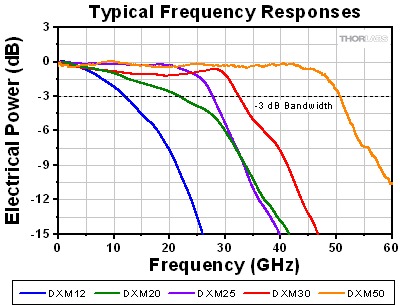
Click to Enlarge
Typical Frequency Responses for the DXM Series Ultrafast Detectors
Please see the blue info icons below (
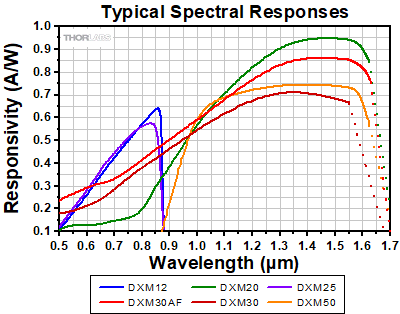
Click to Enlarge
Typical Spectral Responses for the DXM Series Ultrafast Detectors
Measured data is shown by the solid line, while theoretical data is shown by the dotted line. Please see the blue info icons below (
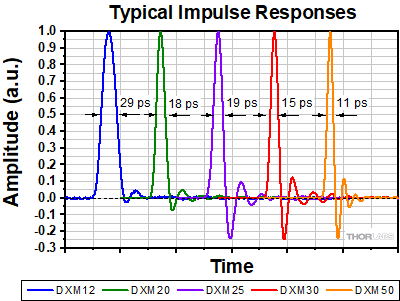
Click to Enlarge
Typical Impulse Responses for the DXM Series Ultrafast Detectors
Please see the blue info icons below (
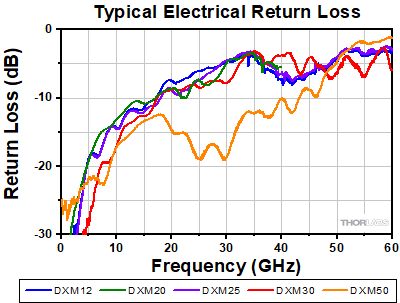
Click to Enlarge
Typical Electrical Return Loss for the DXM Series Ultrafast Detectors
Please see the blue info icons below (
Quick Start Guide

ESD Sensitive Components: Please note that the components inside the DXM series units are ESD sensitive. Take all appropriate precautions to discharge personnel and equipment before making any electrical connections to the unit. This especially applies to coaxial connecting cables that can accumulate capacitive charge.
Charging the Detector: The detector arrives with the battery partially charged. The battery can be fully charged using the included charger and USB adapter cable connected to the USB charger jack indicated in Figure 1. The yellow indicator LED, which is also located on the input panel, illuminates to confirm it is charging properly, and the green LED next to it illuminates when the unit is fully charged. The battery may also be charged using USB chargers for phones, tablets, or similar products. These will charge the battery at a maximum rate of 500 mA. Non-dedicated charging USB ports (e.g. those on a PC) will charge at a lower 100 mA rate.
Mounting the Detector: The included ECM100 mounting clamp, also available below, has a single counterbore that accepts a 8-32 (M4) cap screw (not included). Screw the clamp to the desired base or post before snapping it to the side of the detector housing and securing it using the integrated 5/64" (2 mm) locking screw.
RF and Photocurrent Monitor Output: Connection cables attached to the RF output port, shown in Figure 3, and SMA photocurrent monitor port, shown in Figure 1, must be properly shielded. Attach the RF output of the DXM series unit to the measurement instrument using suitable cables or adapters, such at Thorlabs' microwave cables and adapters. The measurement instrument must have a 50 Ω input and adequate bandwidth to resolve the high-speed signal from the DXM series ultrafast detector. Detectors with max bandwidths of ≤30 GHz have female 2.92 mm RF output connectors, while the 50 GHz DXM50AF detector has a female 1.85 mm RF output connector.
Optical Fiber Input: Ensure the input optical power does not exceed +10 dBm. The FC/PC bulkhead connector used to couple the optical input signal to the detector is located on the input panel of the unit, shown in Figure 1. Fiber connector tips should be cleaned properly before making any connections. While multimode versions of the DXM series may use either single mode or multimode fiber inputs, single mode versions require 9 µm core single mode fiber.
DC Photocurrent Monitor: The DC photocurrent can be monitored directly by viewing the built-in digital display shown in Figure 2, as well as by using most voltmeters to read the analog voltage signal output via the high-impedance SMA jack located on the input panel shown in Figure 1. The units on the displayed digital current measurement can be toggled between µA and mA using the button on the front panel. There may be a small discrepancy (within specification) between the screen and SMA monitor output signal. The digital display reports a wide range of current values, up to 20 mA with a resolution of 1 nA, with the display automatically changing range in response to the signal magnitude. The analog voltage signal sent to the SMA connector has a linear relationship with the measured DC photocurrent up to 3.5 V: the transimpedance gain of the current monitor provides 200 mV per 1 mA of photocurrent. This linear relationship limits the current range reported by the analog SMA output signal, so that the range is smaller than that provided by the digital display.
Cleaning the Housing: Use a soft cloth moistened with mild glass cleaner. Do not spray directly onto unit.
Housing Features
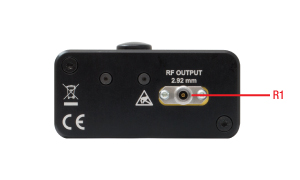
Click to Enlarge
Figure 3: Output Panel of the DXM Series Ultrafast Detectors
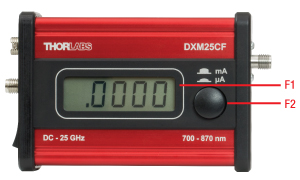
Click to Enlarge
Figure 2: Front Panel of the DXM25CF 25 GHz Detector
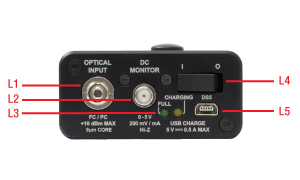
Click to Enlarge
Figure 1: Input Panel of the DXM Series Ultrafast Detectors
| Label | Feature |
|---|---|
| R1 | RF Output (≤30 GHz Detectors: Female 2.92 mm, Item # DXM50AF: Female 1.85 mm) |
| Label | Feature |
|---|---|
| F1 | Photocurrent Monitor Display 4.5 Characters |
| F2 | Range Toggle Switch |
| Label | Feature |
|---|---|
| L1 | Optical Input (FC/PC, 2.0 mm Narrow Key) |
| L2 | Current Monitor Output (Female SMA) |
| L3 | Charging Status Indicator LEDs |
| L4 | Power Switch |
| L5 | Mini-B USB Charger Jack for +5 VDC Input |
Components Included with the DXM Series Ultrafast Detectors
- Detector Head with Hermetically Sealed Detector Module and Built-In Current Monitor
- Individual Test Results for the Specific Device, an Example of which is Here
- DS5 +5 VDC Power Supply with Mini-USB Type B Connector and Location-Specific Plug
- USB 2.0 Type-A to Mini-B Cable
- One ECM100 Aluminum Mounting Clamp
Pulsed Laser Emission: Power and Energy Calculations
Determining whether emission from a pulsed laser is compatible with a device or application can require referencing parameters that are not supplied by the laser's manufacturer. When this is the case, the necessary parameters can typically be calculated from the available information. Calculating peak pulse power, average power, pulse energy, and related parameters can be necessary to achieve desired outcomes including:
- Protecting biological samples from harm.
- Measuring the pulsed laser emission without damaging photodetectors and other sensors.
- Exciting fluorescence and non-linear effects in materials.
Pulsed laser radiation parameters are illustrated in Figure 1 and described in the table. For quick reference, a list of equations is provided below. The document available for download provides this information, as well as an introduction to pulsed laser emission, an overview of relationships among the different parameters, and guidance for applying the calculations.
|
Equations: |
||||
 |
and |  |
||
 |
||||
 |
||||
 |
||||
Peak power and average power calculated from each other: |
||||
 |
and |  |
||
| Peak power calculated from average power and duty cycle*: | ||||
 |
*Duty cycle ( ) is the fraction of time during which there is laser pulse emission. ) is the fraction of time during which there is laser pulse emission. |
|||

Click to Enlarge
Figure 1: Parameters used to describe pulsed laser emission are indicated in the plot (above) and described in the table (below). Pulse energy (E) is the shaded area under the pulse curve. Pulse energy is, equivalently, the area of the diagonally hashed region.
| Parameter | Symbol | Units | Description | ||
|---|---|---|---|---|---|
| Pulse Energy | E | Joules [J] | A measure of one pulse's total emission, which is the only light emitted by the laser over the entire period. The pulse energy equals the shaded area, which is equivalent to the area covered by diagonal hash marks. | ||
| Period | Δt | Seconds [s] | The amount of time between the start of one pulse and the start of the next. | ||
| Average Power | Pavg | Watts [W] | The height on the optical power axis, if the energy emitted by the pulse were uniformly spread over the entire period. | ||
| Instantaneous Power | P | Watts [W] | The optical power at a single, specific point in time. | ||
| Peak Power | Ppeak | Watts [W] | The maximum instantaneous optical power output by the laser. | ||
| Pulse Width |  |
Seconds [s] | A measure of the time between the beginning and end of the pulse, typically based on the full width half maximum (FWHM) of the pulse shape. Also called pulse duration. | ||
| Repetition Rate | frep | Hertz [Hz] | The frequency with which pulses are emitted. Equal to the reciprocal of the period. | ||
Example Calculation:
Is it safe to use a detector with a specified maximum peak optical input power of 75 mW to measure the following pulsed laser emission?
- Average Power: 1 mW
- Repetition Rate: 85 MHz
- Pulse Width: 10 fs
The energy per pulse:

seems low, but the peak pulse power is:

It is not safe to use the detector to measure this pulsed laser emission, since the peak power of the pulses is >5 orders of magnitude higher than the detector's maximum peak optical input power.

Janis Valdmanis, Ph.D. Optics
Ultrafast Optoelectronics
General Manager
Custom and OEM Options
When your application requirements are not met by our range of catalog products or their variety of user-configurable features, please contact me to discuss how we may serve your custom or OEM needs.
Request a Demo Unit
Explore the benefits of using a Thorlabs high-speed instrument in your setup and under your test conditions with a demo unit. Contact me for details.
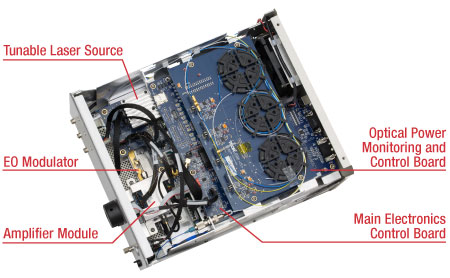
Click to Enlarge
The MX40B Digital Reference Transmitter
Design, Manufacturing, and Testing Capabilities
Thorlabs' Ultrafast Optoelectronics Team designs, develops, and manufactures high-speed components and instrumentation for a variety of photonics applications having frequency responses up to 110 GHz. Our extensive experience in high-speed photonics is supported by core expertise in RF/microwave design, optics, fiber optics, optomechanical design, and mixed-signal electronics. As a division of Thorlabs, a company with deep vertical integration and a portfolio of over 20,000 products, we are able to provide and support a wide selection of equipment and continually expand our offerings.
Our catalog and custom products include a range of integrated fiber-optic transmitters, modulator drivers and controllers, detectors, receivers, pulsed lasers, variable optical attenuators, and a variety of accessories. Beyond these products, we welcome opportunities to design and produce custom and OEM products that fall within our range of capabilities and expertise. Some of our key capabilities are:
- Detector and Receiver Design, to 70 GHz
- Fiber-Optic Transmitter Design, to 110 GHz
- RF & Microwave Design and Simulation
- Design of Fiber-Optic and Photonics Sub-Assemblies
- High-Speed Testing, to 110 GHz
- Micro-Assembly and Wire Bonding
- Hermetic Sealing of Microwave Modules
- Fiber Splicing of Assemblies
- Custom Laser Engraving
- Qualification Testing
Overview of Custom and Catalog Products
Our catalog product line includes a range of integrated fiber-optic transmitters, modulator drivers and controllers, detectors, pulsed lasers, and accessories. In addition to these, we offer related items, such as receivers and customized catalog products. The following sections give an overview of our spectrum of custom and catalog products, from fully integrated instruments to component-level modules.
Fiber-Optic Instruments
To meet a range of requirements, our fiber-optic instruments span a variety integration levels. Each complete transmitter includes a tunable laser, a modulator with driver amplifier and bias controller, full control of optical output power, and an intuitive touchscreen interface. The tunable lasers, modulator drivers, and modulator bias controllers are also available separately. These instruments have full remote control capability and can be addressed using serial commands sent from a PC.
- Fiber-Optic Transmitters, to 110 GHz
- Linear and Digital Transmitters
- Electrical-to-Optical Converters, to 110 GHz
- Modulator Drivers
- Modulator Bias Controllers
- C- and L-Band Tunable Lasers
Customization options include internal laser sources, operating wavelength ranges, optical fiber types, and amplifier types.
Fiber-Optic Components
Our component-level, custom and catalog fiber-optic products take advantage of our module design and hermetic sealing capability. Products include detectors with frequency responses up to 50 GHz, and we also specialize in developing fiber-optic receivers, operating up to and beyond 40 GHz, for instrumentation markets. Closely related products include our amplifier modules, which we offer upon request, variable optical attenuators, microwave cables, and cable accessories.
- Hermetically-Sealed Detectors, to 50 GHz
- Fiber-Optic Receivers, to 40 GHz
- Amplifier Modules
- Electronic Variable Optical Attenuators
- Microwave Cables and Accessories
Customization options include single mode and multimode optical fiber options, where applicable, and detectors optimized for time or frequency domain operation.
Free-Space Instruments
Our free-space instruments include detectors with frequency responses around 1 GHz and pulsed lasers. Our pulsed lasers generate variable-width, nanosecond-duration pulses, and a range of models with different wavelengths and optical output powers are offered. User-adjustable repetition rates and trigger in/out signals provide additional flexibility, and electronic delay-line products enable experimental synchronization of multiple lasers. We can also adapt our pulsed laser catalog offerings to provide gain-switching capability for the generation of pulses in the 100 ps range.
- Pulsed Lasers with Fixed 10 ns Pulse Duration
- Pulsed Lasers with Variable Pulse Width and Repetition Rates
- Electronic Delay Units to Synchronize NPL Series Pulsed Lasers
- Amplified Detectors
Customization options for the pulsed lasers include emission wavelength, optical output powers, and sub-nanosecond pulse widths.
| Posted Comments: | |
Xue Mi
(posted 2024-11-04 14:36:00.61) Hello engineer, I would like to ask how to judge if the detector can work properly, how to build the circuit for calibration testing? If the detector collides, will it have an impact on the high-speed response of the test? We want to check if the instrument itself is working properly.
Looking forward to your reply and good luck with your work! mgarodia
(posted 2024-11-06 09:48:42.0) Thank you for reaching out to us. To start, we suggest performing basic tests such as measuring the detector dark current and characterizing the CW response. An electrical-to-electrical vector network analyzer may be used to measure the S21 response of the system as a function of frequency. We will reach out to you directly to discuss this in more detail as it is beyond the scope of this response. MARK HOLMES
(posted 2022-10-20 12:07:09.88) Hello, This detector seems to be very promising, but I'd like to ask a question about the detector sensitivity below 500nm. I'm aware that the sensitivity is falling off, but would like to know if it falls of more linearly, or does it plateau, as in products such as DET025AFC. ksosnowski
(posted 2022-11-01 05:57:45.0) Hello Mark, thanks for reaching out to Thorlabs. We have not taken continuous responsivity data below the published range, however for DXM25 series this drops to 0.05 A/W at 450nm. Operating into UV range could introduce additional effects from the input fiber. I have reached out directly to discuss this further. Christopher Ebbers
(posted 2022-07-13 09:24:05.21) Is there a repair service for the DXM20AF? The RF output connector (on both of our detectors) varies from max to zero. It appears the bolts holding the connector will loosen. Tightening the bolts is not sufficient, as the connector must be precisely alligned to connect to the circuit board.
Let me know
Thank you
Chris Ebbers
Montana State University jgreschler
(posted 2022-07-26 09:23:11.0) Thank you for reaching out to Thorlabs. Yes Thorlabs offers repair service on these units, you can request service and speak with a technical support engineer by emailing techsupport@thorlabs.com. Hao-Tien Cheng
(posted 2022-03-22 10:15:49.223) We have purchased a DXM30BF ultrafast detector in mid-2019. I would like to receive a data file containing test results of the DXM30BF I purchased. Please contact me (email) and I shall provide the SN # of the photodetector.
The test results for detectors purchased after January 16th, 2020 can be downloaded by clicking on the red Docs icon () next to the Item # and entering your device's serial number under "Download Calibration Data." Please contact Tech Support if you would like to receive a data file containing test results for devices purchased before January 16th, 2020. cdolbashian
(posted 2022-03-25 03:03:00.0) Thank you for reaching out to us with this inquiry. We have contacted you directly to provide these data. user
(posted 2020-04-20 19:58:26.88) Is the 30GHz output AC coupled? Or would I need to include an external DC block to have it be AC coupled? YLohia
(posted 2020-04-21 09:56:01.0) Thank you for contacting Thorlabs. These detectors are DC-coupled. Adding a DC block on the output of a high-speed detector would make it AC coupled. Because the DX/DXM family of detectors has internal termination, no external DC termination is required to bias the detector – this is different from some of the DET products in our catalog, which require an external DC connection between signal and ground to operate. Samrat Sarkar
(posted 2019-12-23 19:50:12.66) Hi Sir,
I am Mr. Samrat Sarkar, Research Engineer at Centre for Development of Telematics, Govt. of India. Currently, in one of our projects, we want to measure optical extinction ratio for an optical pulse train having a repetition rate of 1 GHz with 105 duty cycle for the pulse. The modulator we are using for making this optical pulses ensures an extinction ratio above 40 dB. But, we want to precisely measure the live extinction ratio. Can you please suggest what device from ThorLabs can be used for this purpose?
We are thinking of DXM30AF.
Regards,
Samrat YLohia
(posted 2019-12-26 03:00:52.0) Hello Samrat, thank you for contacting Thorlabs. Based on our direct discussion, unfortunately, we currently do not offer a suitable detector that can resolve a > 40 dB dynamic range signal for your 100 ps pulses. The effective bandwidth of the detector will have to be > 10 GHz and the maximum noise level required would be -28 dBm (1.6 uW) for your peak power of 12 dBm a sampling rate of 10 GHz. The DXM20AF has the lowest NEP of 28 pW/Sqrt(Hz) at your operating wavelength of 1550 nm, which translates to 28 pW * Sqrt(10 GHz)/Sqrt(Hz) = 2.8 uW noise floor. Philip Skochinski
(posted 2019-11-19 14:46:58.423) Does the DXM30 also have a 50 Ohm terminating resistor? The conversion gain (all models, actually) suggests this condition. YLohia
(posted 2019-11-19 04:02:33.0) Yes, there is a 50-Ohm terminating resistor inside the DXM30, and all of the other DXM products. The block diagram for the bare DX module contained inside the DXM module shows this more clearly than the non-existent block diagram for the DXM instrument. pavel.bushev
(posted 2017-10-23 11:21:02.853) Could you please advice us whether the DXM20AF photodetector has an internal trans-imipedance amplifier? tfrisch
(posted 2017-10-24 10:11:14.0) Hello, thank you for contacting Thorlabs. The DXM20AF contains an internal 50-ohm terminating resistor, but it does not have a transimpedance amplifier. I will reach out to you directly to discuss this detector as well. desantic
(posted 2017-05-26 15:56:59.177) Is it possible to have a version of this item operating in the visible range? nbayconich
(posted 2017-06-09 10:51:57.0) Thank you for contacting Thorlabs. We are currently in the process of releasing a new Ultrafast fiber optic photodetector in the visible wavelength region. I will contact you directly with more information. |




Each DXM Series Photodetector includes one ECM100 anodized aluminum clamp, which snaps onto the bottom of the detector's housing and is secured by tightening the flexure lock using the 2 mm (5/64") hex locking screw. Additional ECM100 clamps are available separately. The ECM100 is part of Thorlabs' family of aluminum side clamps that are designed to securely mount Thorlabs' rectangular electronics housings.
The ECM100 has one #8 (M4) counterbored through hole, allowing the clamp to be mounted onto a Ø1/2" post or any surface with an 8-32 (M4) tap. The clamp must be mounted via the counterbored through hole before the electronics housing is attached, as the counterbore will not be accessible once the housing is secured in the clamp.

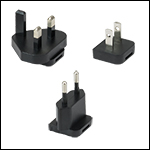
Click for Details
Region-Specific Adapters for DS5
- 5 VDC Regulated Power Supply
- USB Type-A Port
- Compatible with Our DXM and RXM Series of Ultrafast Detectors and Photoreceivers
The DS5 is a 5 V regulated power supply with a USB Type-A female port. It can be used with any USB-compatible device that accepts a 5 VDC output, and is directly compatible with our DXM series of ultrafast fiber optic detectors and our RXM series of ultrafast fiber optic receivers when used with the USB-AB-72 USB cable (sold separately). In addition to the USB-AB-72, we also offer other USB 2.0 cables. A region-specific adapter plug is shipped with the DS5 power supply unit based on your location.
 Products Home
Products Home


















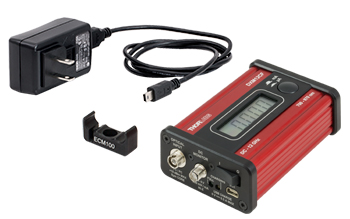

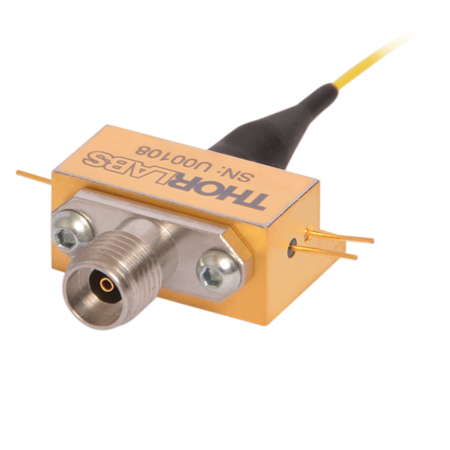
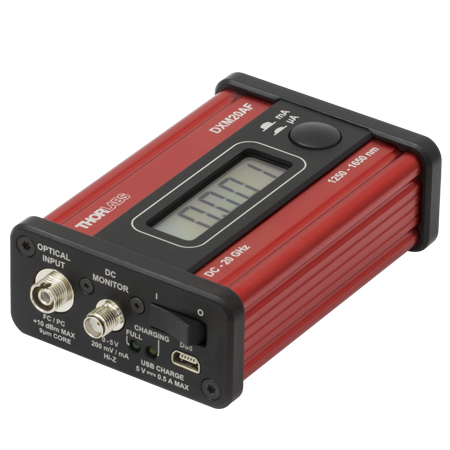




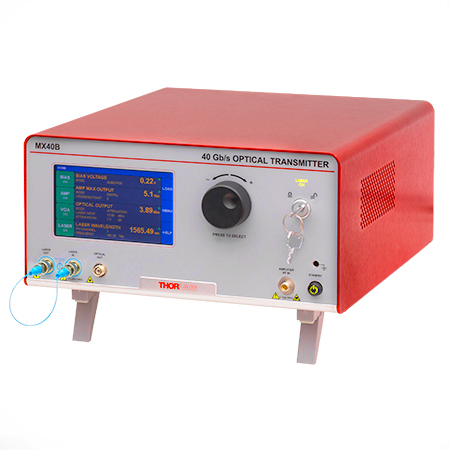


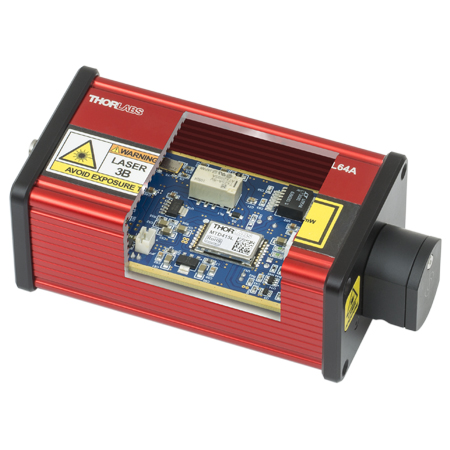

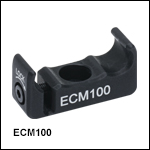
 Zoom
Zoom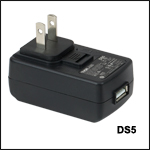
 Telecom-Grade Fiber-Coupled Photodetectors
Telecom-Grade Fiber-Coupled Photodetectors